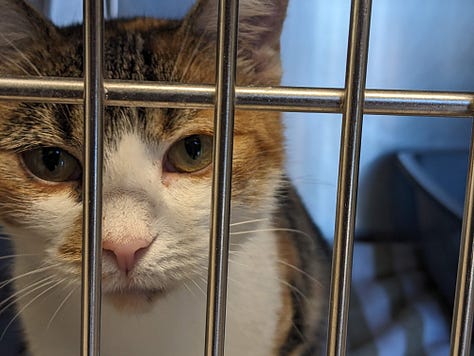The Frog Pond #13: Ancient nuclear reactors (+cute cat photos enclosed!)
Or, I'm entranced by nuclear energy and our new cat!

It’s December, somehow, and a lot is going on!
Highlight: I’ve got a non-fiction essay about Animal Crossing and how it helped me during the pandemic published in Heartlines Spec! I had such fun writing this one, remembering nights spent with friends online and searching for an elusive cat villager from my childhood. Please give it a read and check out the rest of Heartlines Spec’s (a Canadian speculative magazine!) catalogue. The team there is super nice, check out their themed calls for submissions!
Nature’s fission reactor
When you think “nuclear power”, you might think of smokestacks, accidents, or renewable energy1. While humans have been using this energy resource since the early 1900s, did you know there were once naturally occurring fission reactors in the Earth?
The case of the missing uranium
In 1956, uranium was discovered in a remote region of Gabon. Prospectors from France, which colonized Gabon from 1910 until 1960, opened mines with a minority share given to the State of Gabon234. France mines uranium in Gabon to power their nuclear industry to this day with an 85% stake in the mining company, with dangerous conditions for miners from overexposure to radioactive material at worksites5.
Samples of uranium from the Oklo Mine in Gabon in 1972 showed a surprisingly low amount of Uranium-235 than normal concentrations6. Uranium-235 is an isotope of uranium that makes up 0.72% of natural uranium7, but the samples only contained 0.60%.
This was a big deal, because international laws mandate regulations of all fissionable isotopes such as Uranium-235 to ensure no one’s making nuclear weapons. Fissile material (something that can undergo nuclear fission when struck by a low energy neutron8) like uranium is important to keep track of, both for nuclear energy production (more enriched = better fuel = higher cost) and for safety910.
So where did that 17% of the U-235 go?
It’s not where; it’s when
Mining was suspended in the Oklo mines for 2 years to investigate the anomaly, and investigators published their findings in 197811.
Another deposit had been found in 1953 in Democratic Republic of the Congo (then colonized by Belgium for resources such as copper and cobalt. Cobalt mining has a long history of human rights abuse, especially child slavery1213 that continues to this day fueled by its demand in making lithium batteries14), but was not found to have the size to reach a critical uranium chain reaction. In a 1956 paper on the subject, it was stated that it seemed highly unlikely that natural reactors could be found on Earth15.
Scientists in Gabon discovered the presence and lack of presence of different isotopes to mean that the missing uranium-235 wasn’t stolen; it had been used.
2 billion years ago (roughly when all multicellular organisms started forming in the oceans16) there were 17 natural nuclear fission reactors17 operating in what is now Gabon in Western Africa.
1,000 ancient lightbulbs
These reactors weren’t like commercial power plants. Over a few hundred thousand years, they only averaged about 100 kilowatts18. That’s about 1,000 lightbulbs, total.
The thing that makes these natural reactors so cool isn’t their power input. Its nuclear fission products have been safely contained since it began reacting. This shows that long-term geologic storage of nuclear waste can be done19!
How does it work??
To date, no other natural nuclear reactors have been discovered except the ones in Gabon. The reactor sites themselves have long since been completely mined out and destroyed, but scientists have used the samples to conduct studies and reverse engineer the condition that would allow this phenomena to occur20.
There are 4 things you need to create a natural nuclear reactor:
- Natural uranium ore in a thick, highly concentrated amount.
- A significant amount of Uranium-235.
- A moderator, aka an element/mineral that can slow down the neutrons to make it more probable that a chain of neutron collisions can occur.
- No significant amount of neutron-absorbing elements to stop the chain reaction.21
Why was 2 billion years ago the sweet spot for these reactor to occur?
The Great Oxidation Event 2.4 billion years ago is the key. Oxygen levels on Earth increased from less than 1% to over 15% of Earth’s atmosphere (thanks, photosynthetic ancient algae!)22. Increased oxygen allowed the uranium deposits to become more mobile and concentrated through “hydrothermal circulation”, or the circulation of water thanks to heat within the Earth’s crust.
Gabon had this event specifically because of its marine sandstone deposits. The minerals in the underwater sandstone mixed with the oxidizing water and became highly concentrated. Fission could have started once the uranium concentration reached 10%—it developed at 25-60% in Gabon.
With high concentrations of uranium, including uranium-235, water as a neutron moderator, and no neutron-absorbing elements to hold it back, the natural nuclear fission reactor was born23.
A relic that will stay in the past
Naturally occurring fission reactors cannot happen today. Unlike 2 billion years ago when 3.6% of uranium was U-235, concentrations of uranium-235 in natural uranium are too small (0.72%) due to decay to sustain a reaction24. Those four fundamental conditions can no longer be met outside human interference.
If you like these science dives, please consider sharing The Frog Pond with a friend! I love making them and it always makes me happy to see anyone else enjoying geeking out about these topics :)
A word from a passing frog
WE GOT A CAT!
After years of wanting a cute little friend but not having the resources, space, or permanency we needed, we’ve finally been able to get a cat!
Meet Hazel!
We adopted her from the local Shelter on November 25. She was first found as a stray with a litter of her kittens. She was adopted by an older women who found she couldn’t take care of her because Hazel was too timid. On the day that she brought her back, we came to take a look at the cats. It honestly feels like fate that we were there at exactly the right time, no earlier or later, to adopt her!

We were warned that it could take weeks for her to show her face for more than meals. But with a ton of help from our research watching Jackson Galaxy (seriously, he had great advice!), and a lot of patience, we managed to coax her into open spaces by day 2! And now she’s happy to follow us around, play with us, and sleep between us on the couch while we watch TV.
We think she might be closer to 1 than 2, and still in her “teenage” years as a cat. She’s SUCH a little snuggle bug and we’re hopelessly in love with her.

Writing
I’m on my second edit round before going on sub! Revisions are my most intimidating part of the writing process, but I’ve been developing some strategies (mainly spreadsheets) to help break up the big tasks into smaller, easy to pick at pieces.
It’s at once both exciting to work on what may be the last major revision of this book before it gets sent off, and a little intimidating! I’m trying hard not to overthink/start re-writing when I don’t need to. There’ll be some self-doubt along the way, but there’s also a fun re-discovery of the lines I love, and polishing up others from the experiences I’ve had since I first wrote this thing last year!
Reading
I Feed Her to the Beast and the Beast Is Me by Jamison Shea: A YA contemporary eldritch horror novel featuring Laure, a Black ballerina in the Paris Opera company trying to get noticed for her skill and forging a deal with a blood god to do so. This was a really fun book, I loved the drive and ruthlessness of the protagonist and the dive into the elitist and racist systems in professional ballet. I highly recommend it, I think it’s a great example of an “unflinching” book. I was surprised how far it went in the social horror in a great way. There’s a sequel in the works and I’m very interested in what that will hold!
I also read about 25% of Starling House by Alix E. Harrow then accidentally returned it on Libby. The book (a contemporary gothic dark fantasy) discusses growing up poor and marginalized, rumours in small towns, and the way wealth clings to rich families and warps them, but I’ll have to wait for my next loan to really dig in further.
Reading-adjacent, I’ve been getting back into Welcome to Night Vale! I’m 68 episodes into my re-listen. I loved this bizarre horror-comedy podcast back when I first listened in early university, and now it has aged to be even more starkly satirical. If you’ve never dipped your toe into fiction podcasts, this is 100% a great place to start!
I went to see the Hunger Games prequel this month, and it made me want to re-read the original trilogy again. So I am! I’m about 100 pages into The Hunger Games and it’s fascinating to read it with an adult lens after 10ish years since I last read it. The sentence structure is fascinating—so many effective run on/compound sentences with the purpose of showing how much Katniss is thinking about at one time that gives such a frantic feeling, and the outstanding voice reminds me again why this was a mega-bestseller. I’m having a lot of fun reading the books, I think I’ll re-watch the movies soon too!
Footnotes
1
For the record, I am very pro-nuclear energy, especially as power source to cover demand during the transition from oil to renewable! I’m especially interested in the liquid salt reactor designs that are being developed in Canada by ~2030.
2
https://www.bbc.com/news/world-africa-13376333
3
https://www.archontology.org/nations/gabon/01_polity.php
4
https://world-nuclear.org/information-library/country-profiles/others/uranium-in-africa.aspx
5
https://www.asso-sherpa.org/health-of-uranium-miners-at-areva-sites-in-gabon-and-niger
While this Frog Pond focuses on a natural phenomena, I think it’s important to highlight the social and political context of its discovery, and of the exploitation of both people and resources that continue to this day by a country seizing and retaining control just because they can, like so many other colonial projects.
6
https://arxiv.org/pdf/1404.4948.pdf
I originally wanted to cite an article from the International Atomic Energy Agency, but they had some numbers wrong in this statistic that showed potentially sloppy copy-pasting or a misunderstanding of the data and I didn’t trust it enough to keep using it as a source.
7
https://arxiv.org/pdf/1404.4948.pdf
8
https://www.nrc.gov/reading-rm/basic-ref/glossary/fissile-material.html
9
https://www.nrc.gov/security/domestic/mca/snm.html
10
11
https://arxiv.org/pdf/1404.4948.pdf
12
https://www.bbc.com/news/world-africa-67569996
13
https://www.amnesty.org/en/documents/AFR62/7009/2023/en/
14
15
https://arxiv.org/pdf/1404.4948.pdf
16
https://www.eol.org/pages/2908256
If you love learning about ancient life on Earth, check out last month’s feature on the first apex predator, the mega-shrimp!
17
18
19
20
21
22
23
24





